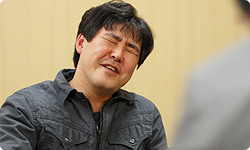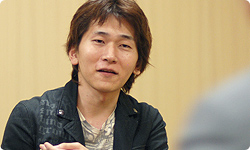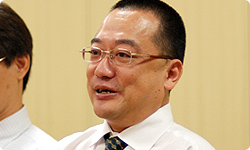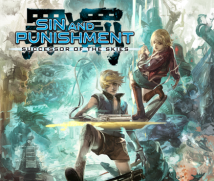2. Painful Memories
It seems your experience developing Sin and Punishment for the N64 was so painful it still causes you to sigh loudly. Could you tell us exactly what happened?
Well, the crosshairs in an aim-and-shoot game move in 2D, but…
The game world is in 3D.
Exactly. You have to use 2D aiming to hit a 3D opponent with a bullet. I was like, “How am I supposed to do that?!” And that’s how it all began.
I see.
So I tried a bunch of stuff, and eventually figured out how to hit enemies with bullets.
I see.
But then next… (makes a pained face)
Next?
The opponent’s bullets wouldn’t hit you.
(laughs)
Ah, opponents couldn’t hit the player. (laughs)
When the player character isn’t on the screen, you can fudge it, but we were making a game with a visible player character, so there could be no fudging it.
If it were just a little off, it would be unnatural and not feel right.
That’s right. So many painful memories… Like with the bosses, too.
The bosses?
Bosses have to be big so they make an impact. If they aren’t…
They’re not a boss.
Right. But in 3D, they’re way back in the screen.
Which is normal.
When we put them on the screen, though, they were so small. We were like, “That’s not a boss!” In reality, they were really big.
They were really big, but looked really small.
(with a pained expression) Yeah…
What a problem. (laughs)
Yep. In Sin and Punishment, you can get up close and attack, so I thought the bosses’ large size would be apparent then. But up close, they were too big!
(laughs)
(with a troubled expression) They wouldn’t fit on the screen.

When one came close, you couldn’t tell if it was a boss or something else.
Right. You couldn’t see anything but a big foot. You would think, “Well, this is probably a boss…although maybe it’s actually just a foot.”
(laughs)
So many painful experiences.
(nods in silence)
When Sin and Punishment came out, I thought it was a very ambitious game. I thought, “They sure have big aspirations for the Nintendo 64!” Nakagawa-san, were you originally the type to enjoy pushing boundaries?
Yes. (firmly)
I thought so.
I like it…but it’s hard.
(laughs)
He’s always been that way, challenging the hardware limits of the NES, and so on.
In the days of the NES and Super NES, digging up uses of the hardware that weren’t in the specifications and being pioneers was a sort of bliss for programmers.
That’s right.
I would get frustrated when I ran across something in another company’s game that I had no idea how they had accomplished, but I would be pleased when I saw how surprised people were by something we had made.
I know what you mean. We continued on in that spirit when we made the Nintendo 64 version.
So, Nakagawa-san, you kept your shoulder to the wheel and…
Yes. Then we ran into a wall of colossal proportions. Not just trouble in programming, but in design as well.
You had trouble, too, Suzuki-san?
Yes. In design, I remember having particular trouble with texture mapping.9 9Texture mapping: Laying images on 3D objects to establish differences in textures and characters.

With the Nintendo 64, the size of textures was severely limited. If you didn’t contrive something clever when making the data, the processing speed would drop dramatically.
That’s right. In order to avoid that, we tried things like removing bones.10 It was a matter of whether or not we could turn the constraints into a positive feature. 10Removing bones: Decreasing the number of joints in a 3D model.
By the way, there’s a tendency these days for a large number of people to be involved in the development of a game, but at Treasure you do powerful work with small numbers.
Yes, I suppose so.
I’m often surprised by what you accomplish with a team of such size. I have the impression that you make incredibly powerful games.
Well, we go about it rather frantically…
(nod repeatedly)
(laughs)
I basically hold the policy of letting the staff make the game however they like. But if, say, 30 people each tried to make what he or she truly liked, they would never agree on anything. Everyone would have their own opinion, saying, “This is what I want to do!” “The few and the proud” isn’t just a cool-sounding philosophy. You really can’t make anything with large numbers.

With too many people, it just doesn’t come together. (laughs)
Right. You need someone, like Nakagawa this time, to be director and programmer and pull it all together. That’s why in the first stage of this project we had the absolute minimum staff - two programmers and two designers - make the game’s core elements, and began with just a few people. Of course, in the end more people were involved than ever before in Treasure’s history.
When those core elements were established, I had you show it to me, and even then I felt like it had substance.
As I’m sure you’re well aware, back in the days of the NES, one person could make a whole game.
That’s right. Once upon a time, there was just one programmer. It was normal for the whole team to consist of only three people.
Even now, Treasure is like that!
(laughs)
Even today it’s normal for three people to be a team at our company. That way they can do what they want and really make it stand out. But it’s not like that’s the only reason I insist on my policy of working in small numbers. The reality simply is we don’t have many people…
(nod in agreement)
(laughs) To put a good spin on it, you want to make the most of each individual’s energy when making something.
Yes, but to say we just do whatever we want wouldn’t be wrong either. (laughs)
